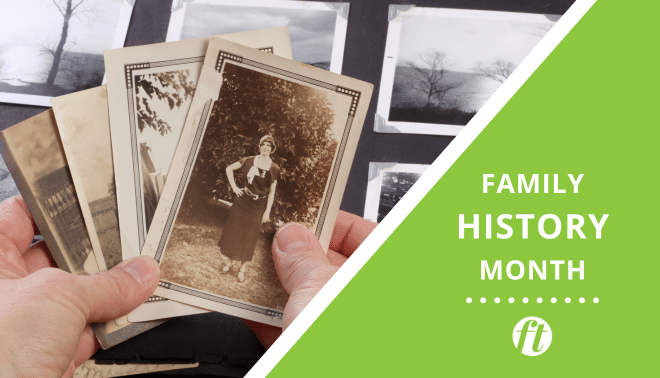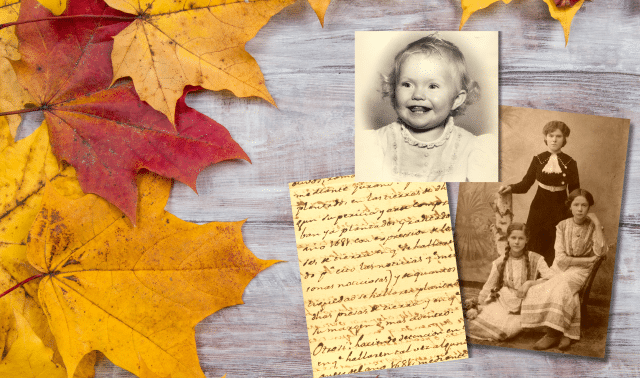Sign up for the Family Tree Newsletter! Plus, you’ll receive our 10 Essential Genealogy Research Forms PDF as a special thank you.
Get Your Free Genealogy Forms
"*" indicates required fields

Not only is October Family History Month, it’s also a perfect opportunity explore the spookier side of genealogy: visiting burial places and exploring death records. Here are five fall-ish family history activities to help you celebrate the season!
1. Visit a family’s burial place
Do this in-person if you can, or virtually if it’s too far away. (If you’re searching from afar, turn to top cemetery websites to locate your ancestor’s place of rest.) Find your relatives’ headstones. Study them for clues about their lives. Take clear, close-up photographs of their markers; you may want to take several until you get the optimum angle and lighting. (As a reminder: Preservationists don’t recommend creating tombstone rubbings and, in some places, the practice is illegal.)
Next, look for other family burials nearby. Take a minute to appreciate what you see. Image those headstones individually and then take a few “group shots” to show how they’re clustered. Walk around the cemetery to learn more about the context in which that person was laid to rest. Was the cemetery segregated into chronological, ethnic or religious sections? This article is packed with tips to help you get the most out of a trip to the cemetery.
2. Image tombstones
Help document the world’s cemeteries before inscriptions fade and stones crumble away—it happens faster than you’d think. Search for burial grounds near you at Find A Grave>Cemeteries>Browse by Location, or by using the BillionGraves website (Research>Cemetery Search) or mobile app (Cemeteries):


Watch for cemeteries that don’t have few or no tombstones listed (on BillionGraves, those without any entries show up as blue icons). Follow instructions on the site to take and upload photos of individual gravestones. Transcribe them, too, if you like.
For bonus points, respond to someone’s request for a tombstone image. At BillionGraves, watch for an orange icon on the cemetery map, which means someone has requested a gravestone image. Select that cemetery, scroll down and click on a Photo Request and follow the instructions. At Find A Grave, go to an individual cemetery’s home page and click on Photo Requests.
3. Gather obituaries
Review your family tree for all relatives who have died within the last 120 years, or even the last 150 years. These are the ones most likely to have had obituaries or death notices appear in newspapers. Gather as many as you can find for each relative; sometimes different papers ran slightly different versions of an obituary. Places to look for obituaries:
- The free US newspaper website, Chronicling America, and other collections of digitized newspapers online.
- Huge collections of indexed obituaries are at the free website FamilySearch (United States, GenealogyBank Obituaries, Births, and Marriages 1980-2014) and subscription website Ancestry.com (try the U.S., Obituary Collection, 1930-Current). Don’t neglect smaller collections obituaries at these websites; search by record type, narrowing the category down to death records. If you participate in the FamilySearch global Family Tree, you can explore obituaries that have already been found for your ancestors.
- Genealogy subscription websites Findmypast and MyHeritage both have large collections of digitized newspapers you can search yourself. At Findmypast, go to Search > Newspapers & Periodicals > US and World Newspapers. Enter a name and any desired keywords across the top of the screen and run the search. Afterward, narrow the search results by state and even by newspaper. At MyHeritage, go to Research>Newspapers. Run a search for your relatives from this main page, or choose a collection in which to target your search.
- Contact local-to-your-ancestors public libraries and genealogical societies to see what resources they offer for finding obituaries.
4. Review death certificates
Do another sweep of your family tree for death records. Do you have copies of these (not just indexes) for every possible relative in the past 150 years? If you don’t, search for online collections you may have missed by Googling terms such as death records Pennsylvania genealogy or searching the FamilySearch Research Wiki for articles about specific locales, which may point to resources you need.
If you don’t find any civil death records online, the FamilySearch Research Wiki may tell you why not (perhaps the state doesn’t make them publicly available). Sometimes death certificates are available but you have to contact a state or county office to request a copy. The searches recommended in this section will likely include results that tell you how to do this. Ordering individual records can be pricey, but for key relatives, may be worth it.
5. Look for alternative records
Even if you find a headstone, obituary and a death certificate, other end-of-life records may reveal even more about your family history—or lead you back to missing records. For example, I wasn’t able to obtain a death certificate for Henry Fox because these are restricted by Colorado law. But I contacted the cemetery office, which pointed me to the funeral home, which sent me a copy of his file. The file contained a copy of his death certificate and several versions of his obituary.
Records you might search for include:
- Cemetery plot purchases, sexton’s records, maps or other records
- Funeral home records
- Wills and probate records (these aren’t always easy to access in county courthouses but Ancestry.com has posted more than 170 million records spanning all 50 states)
- Coroner’s records, if an autopsy was performed
Mine these documents for every genealogical clue they may hold. Compare those clues across all the records you find, to verify what you’ve learned and watch for inconsistencies. Then use those clues to learn even more (for example, follow that mention of a school, church or job in an obituary to related records). Death-related records don’t just tell you about someone’s death: they often reveal clues about that person’s life, too.








